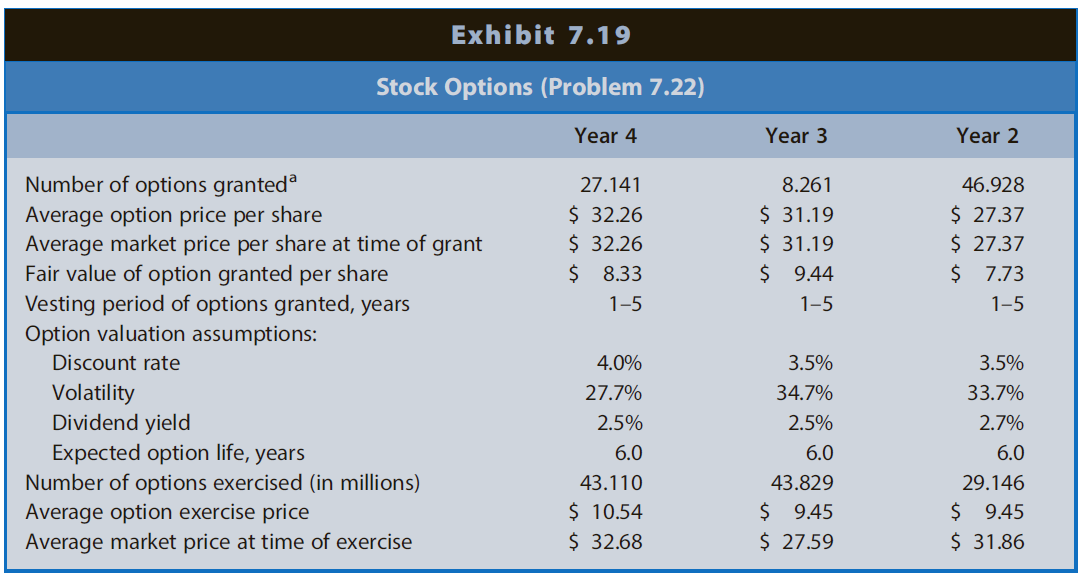Exhibits 7.17 and 7.18 provide footnote excerpts to the financial reports of The Coca-Cola Company and Eli
Question:
Exhibit 7.17
The Coca-Cola Company
Stock Option Disclosures
Note-Stock-Based Compensation (partial footnote disclosure)
Our Company currently sponsors stock option plans. Effective January 1, 2002, our Company adopted the preferable fair value recognition provisions of Statement of Financial Accounting Standards (''SFAS'') No. 123, ''Accounting for Stock-Based Compensation.'' The fair values of the stock awards are determined using a single estimated expected life. The compensation expense is recognized on a straight-line basis over the vesting period. The total stock-based compensation expense, net of related tax effects, was $254 million in 2004, $308 million in 2003, and $267 million in 2002. generates from the stock-based compensation provided to its employees?

Exhibit 7.18
Eli Lilly and Company
Stock Option Disclosures
Note-Stock-Based Compensation (partial footnote disclosure)
We adopted Statement of Financial Accounting Standards No. 123 (revised 2004), Share-Based Payment (SFAS 123R), effective January 1, 2004. SFAS 123R requires the recognition of the fair value of stock-based compensation in net income. Stock options are granted to employees at exercise prices equal to the fair market value of our stock at the dates of grant. Generally, options fully vest three years from the grant date and have a term of 10 years. We recognize the stock-based compensation expense over the requisite service period of the individual grantees, which generally equals the vesting period.
We recognized compensation cost in the amount of $108.2 million and $25.2 million in the first quarter of 2004 and 2003, respectively, as well as related tax benefits of $32.8 million and $8.8 million, respectively.
Beginning with the 2004 stock option grant, we utilized a lattice-based option valuation model for estimating the fair value of the stock options. The lattice model allows the use of a range of assumptions related to volatility, risk-free interest rate, and employee exercise behavior. Expected volatilities utilized in the lattice model are based on implied volatilities from traded options on our stock, historical volatility of our stock price, and other factors. Similarly, the dividend yield is based on historical experience and our estimate of future dividend yields. The risk-free interest rate is derived from the U.S. Treasury yield curve in effect at the time of grant. The model incorporates exercise and post-vesting forfeiture assumptions based on an analysis of historical data. The expected life of the 2004 grants is derived from the output of the lattice model.
The weighted-average fair values of the options granted in the first quarter of 2004 were $16.06 per option, determined using the following assumptions:
Dividend Yield ............................................................................ 2.0%
Weighted-Average Volatility ..................................................... 27.8%
Range of Volatilities .................................................................. 27.6%-30.7%
Risk-Free Interest Rate ............................................................. 2.5%-4.5%
Weighted-Average Expected Life ............................................ 7.2 years
As of March 31, 2004, the total remaining unrecognized compensation cost related to non-vested stock options amounted to $397.5 million which will be amortized over the weighted-average remaining requisite service period of 2 years.
REQUIRED
Review Exhibits 7.17 and 7.18 and answer the following questions.
a. Explain the concept of vesting. Discuss why firms typically include a vesting feature in the stock-based compensation plans that they offer to their employees.
b. What are the vesting characteristics of the two plans discussed in the exhibits? What effect do they have on stock-based compensation expense using the fair value method?
c. For each firm, (1) what is the life of the options granted, (2) how does option life relate to the vesting period, and (3) why might the weighted-average expected life of the options be less than the full life of the options?
d. The Coca-Cola Company uses the Black-Scholes valuation model for estimating the fair value of the stock options, whereas Eli Lilly and Company utilizes a lattice-based option valuation model. Both valuation techniques are permitted by U.S. GAAP. Perform an Internet search to determine which valuation model is more commonly used by the largest publicly held firms. Speculate on why this is the case.

Step by Step Answer:

Financial Reporting Financial Statement Analysis And Valuation A Strategic Perspective
ISBN: 1711
9th Edition
Authors: James M. Wahlen, Stephen P. Baginski, Mark Bradshaw





